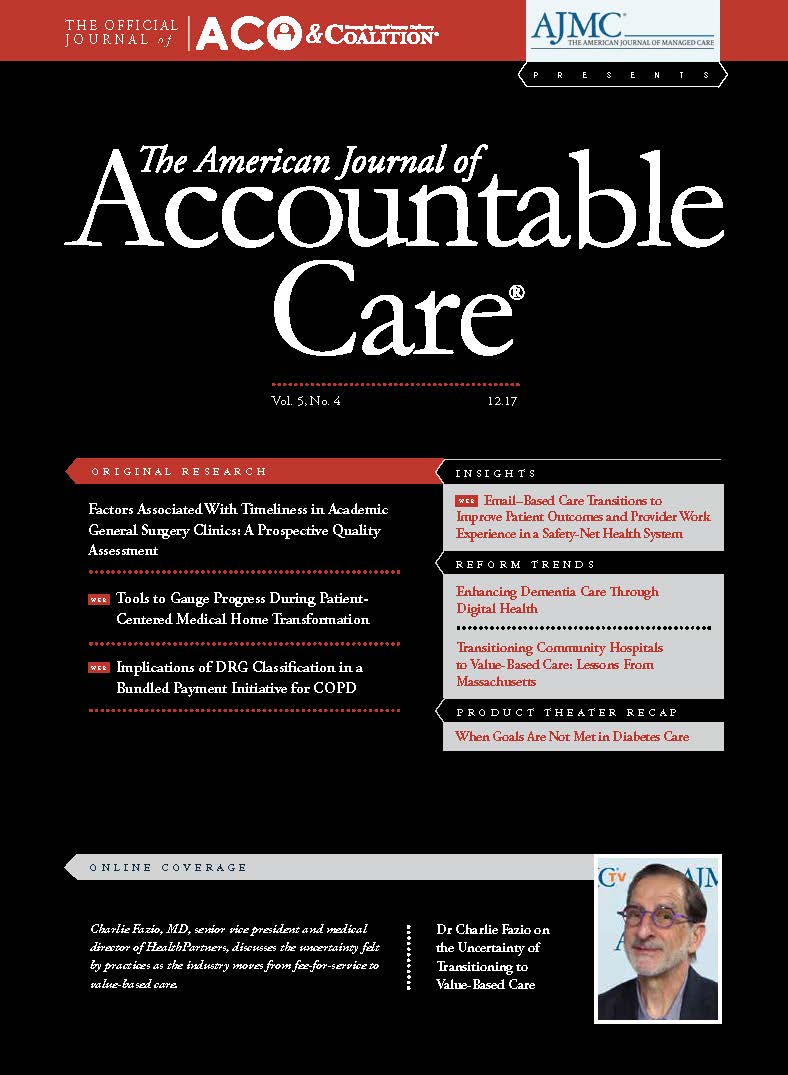Publication
Article
Population Health, Equity & Outcomes
When Goals Are Not Met in Diabetes Care
A presentation at the fall live meeting of the ACO & Emerging Healthcare Delivery Coalition® focused on the clinical and economic consequences of not meeting glycemic goals in patients with type 2 diabetes.
Clinical and economic burdens are placed on the US healthcare system when target goals are not met in diabetes care. In 2012, total costs (direct and indirect) associated with diabetes in the United States were $245 billion dollars.1 In a presentation at the 2017 Fall ACO & Emerging Healthcare Delivery Coalition®, hosted by The American Journal of Managed Care® on October 26th, 2017, Kari Uusinarkaus, MD, discussed the economic impact of type 2 diabetes (T2D). This presentation focused on the prevalence, costs, and consequences of not meeting glycemic goals in patients with T2D.
Approximately 16.5 million people in the United States have T2D.2 The majority of adult patients (90%-95%) with diabetes have T2D.1 Risk factors associated with the occurrence of T2DM include ethnicity (eg, American Indians, African Americans, Hispanics/Latinos, Asians, Native Hawaiians, Pacific Islanders), male gender, older age, obesity, family history, gestational diabetes, impaired glucose metabolism, and physical inactivity.
Diabetes increases the risk of developing complications (eg, neurological, peripheral vascular, cardiovascular, renal, endocrine/metabolic, ophthalmic).3 More than 60% of patients with T2D die from cardiovascular disease.4 From 1998 to 2011, the overall death rate among patients with T2D was 38.64 per 1000 person-years.5 The risk of death in patients with T2D increased in patients who were diagnosed at a younger age, who lacked glycemic control, and/or who experienced greater severity of renal complications.
Both the American Diabetes Association (ADA) and the American Association of Clinical Endocrinologists/American College of Endocrinology (AACE/ACE) have established target goals to decrease cardiovascular comorbidities associated with T2D.6,7 These recommended targets are described in Table 1.
Achieving glycemic goals reduces long-term cardiovascular disease and diabetes-related complications. A prospective UK database study found that intensive glycemic control (to achieve glycated hemoglobin [A1C] goals <7%) significantly decreased rates of microvascular and neuropathic complications in patients with T2D.7,8
- 16% reduction in cardiovascular disease events (combined fatal or nonfatal myocardial infarction and sudden death)
- 13% reduction in myocardial infarction after 10 years of follow-up
- 27% reduction in all-cause mortality after 10 years of follow-up.
An alarming number of patients with T2D are not meeting glycemic goals and other important goals (eg, blood pressure, body mass, cholesterol). According to a study reported in The American Journal of Managed Care® that focused on patients taking metformin and a sulfonylurea, 31% to 92% of patients failed to reach recommended glycemic goals.9 In particular, more than 70% of patients were not meeting the recommended A1C goal of less than 7%. Data from the National Health and Nutrition Examination Survey found that only 30% to 50% of US patients with diabetes met the individualized targets for glycemic control, blood pressure, and/or lipid control.10 Additionally, 40% to 50% of patients were not taking advantage of preventive measures (eg, diabetes education, vaccinations, and annual dental examinations).
Hypoglycemia is a major rate limiting factor in the glycemic management of T2D.7 Diabetes control and quality of life can be severely compromised in patients with hypoglycemia unawareness or hypoglycemia-associated autonomic failure. For example, a history of severe hypoglycemia among older adults with T2D is associated with increased risk of dementia. In 2017, the ADA altered the glycemic target to 80 to 130 mg/dL (4.4-7.2 mmol/L) as a method to limit overtreatment and to provide a safety margin for patients titrating glucose-lowering drugs such as insulin.
Improved diabetes control with oral therapies can lead to decreased costs of care.9,11 According to a study published in The American Journal of Managed Care®, goal attainment was associated with significantly lower total diabetes-related healthcare costs per person per year.9 The results were also consistent in patients who were older than 65 years. As shown in Table 2, a meta-analysis of 56 studies from 20 countries also found that many of the ADA-recommended interventions were cost-saving or cost-effective.11
T2D affects more than 16 million patients in the United States and the total economic burden is high.2 Achieving glycemic and related diabetes goals decreases long-term cardiovascular disease and complication rates.7,9 An increase in goal attainment is associated with decreased diabetes-related healthcare costs.9REFERENCES
1. National diabetes statistics report, 2014. CDC website. stacks.cdc.gov/view/cdc/23442/cdc_23442_DS1.pdf. Published July 2014. Accessed December 4, 2017.
2. Dall TM, Zhang Y, Chen YJ, Quick WW, Yang WG, Fogli J. The economic burden of diabetes. Health Aff (Millwood). 2010;29(2):297-303. doi: 10.1377/hlthaff.2009.0155.
3. American Diabetes Association. Economic costs of diabetes in the U.S. in 2012. Diabetes Care. 2013;36(4):1033-1046. doi: 10.2337/dc12-2625.
4. Duckworth W, Abraira C, Moritz T, et al; VADT Investigators. Glucose control and vascular complications in veterans with type 2 diabetes. N Engl J Med. 2009;360(2):129-139. doi: 10.1056/NEJMoa0808431.
5. Tancredi M, Rosengren A, Svensson AM, et al. Excess mortality among persons with type 2 diabetes. N Engl J Med. 2015;373(18):1720-1732. doi: 10.1056/NEJMoa1504347.
6. Handelsman Y, Bloomgarden ZT, Grunberger G, et al. American Association of Clinical Endocrinologists and American College of Endocrinology - clinical practice guidelines for developing a diabetes mellitus comprehensive care plan - 2015. Endocr Pract. 2015;21(suppl 1):1-87. doi: 10.4158/EP15672.GL.
7. American Diabetes Association. 5. glycemic targets. Diabetes Care. 2016;39(suppl 1):S39-S46. doi: 10.2337/dc16-S008.
8. UK Prospective Diabetes Study (UKPDS) Group. Intensive blood-glucose control with sulphonylureas or insulin compared with conventional treatment and risk of complications in patients with type 2 diabetes (UKPDS 33) [published erratum appears in Lancet. 1999;354(9178):602]. Lancet. 1998;352(9131):837-853. doi: 10.1016/S0140-6736(98)07019-6.
9. Lafeuille MH, Grittner AM, Gravel J, et al. Quality measure attainment in patients with type 2 diabetes mellitus. Am J Manag Care. 2014;20(suppl 1):S5-S15.
10. Ali MK, Bullard KM, Saaddine JB, Cowie CC, Imperatore G, Gregg EW. Achievement of goals in U.S. diabetes care, 1999-2010. N Engl J Med. 2013;368(17):1613-1624. doi: 10.1056/NEJMsa1213829.
11. Li R, Zhang P, Barker LE, Chowdhury FM, Zhang X. Cost-effectiveness of interventions to prevent and control diabetes mellitus: a systematic review. Diabetes Care. 2010;33(8):1872-1894. doi: 10.2337/dc10-0843.






